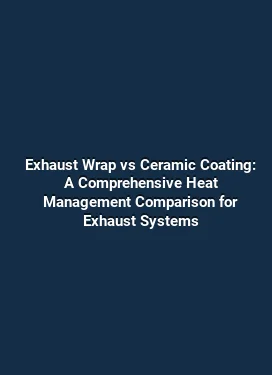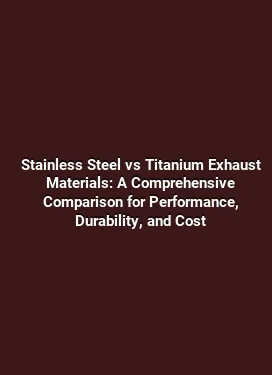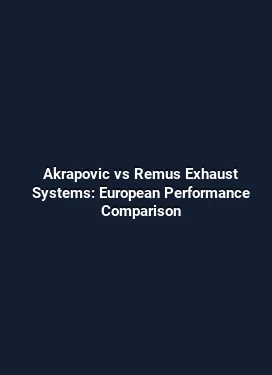Equal Length vs Unequal Length Headers for Subaru Boxer Engine Sound
Subaru’s flat-four, or boxer, engine is renowned for its unique sonic footprint. The characteristics of this sound are influenced by multiple factors: exhaust piping, catalytic converters, mufflers, and importantly, the header design. In the realm of exhaust systems, two common approaches stand out for boxer engines: equal length headers and unequal length headers. This article delves into how each design modulates the sound, explains the underlying acoustics and scavenging effects, and provides practical considerations for selecting the right setup for daily driving, spirited street use, or light track work.
Understanding Equal Length Headers

How equal length headers influence exhaust gas flow

Equal length headers are engineered so that each cylinder’s exhaust pulses travel roughly the same distance to meet at the collector. This synchronization tends to create a more uniform pressure wave, which can improve scavenging at certain RPM bands. For a Subaru boxer engine, where two pairs of cylinders fire in a vecino pattern, this synchronization helps to balance the exhaust pulses from the opposite sides of the engine. Practically, the result is a more linear exhaust gas flow with a smoother tone. Enthusiasts often report a crisp, steady note with reduced rasp at mid-range RPMs. The design also helps in reducing backpressure slightly, which can yield marginal gains in throttle response and a touch more peak power in specific configurations.
From an acoustical perspective, equal length headers can emphasize a cleaner, more refined resonance. The chambering effect around the collector tends to produce a consistent note that some drivers describe as a “surgical” tone—precise and controlled rather than aggressive and jagged. In street-oriented builds, this translates to a more dignified rumble that remains pleasantly audible without becoming harsh on long drives.
Material and construction considerations
The benefit of equal length headers is not only in the geometry but also in the quality of welds, material, and the diameter of primary tubes. Stainless steel with good wall thickness resists heat-induced distortion, maintaining the intended lengths and angles. Teflon-coated or ceramic-coated headers can further reduce under-hood temperatures, helping maintain consistent exhaust flow and preventing heat soak from altering the pulse timing. A well-constructed equal length header set tends to retain its sonic characteristics longer, even after many heat cycles and road use.
Understanding Unequal Length Headers
How unequal length headers shape the boxer engine sound
Unequal length headers deliberately place primary tubes at different lengths before they merge into a common collector. This intentional mismatch creates a varied arrival time for the exhaust pulses, which blends into a more complex acoustical profile. For many Subaru owners, unequal length designs emphasize a coarse, more aggressive tone with pronounced mid- to high-frequency harmonics. The sound often carries a louder rasp or crackle when the engine revs high, contributing to a sportier audio character that many drivers find exhilarating.
On the performance side, unequal length headers can enhance scavenging across a different RPM range compared to equal length designs, especially when paired with a high-flow catalytic converter and a well-tuned exhaust system. The trade-off is that the sound can become more variable, with shifts in loudness and tone depending on load, gear, and RPM. For daily drivers, this rasp might be desirable only in certain rpm windows and could translate to noticeable cabin drone at highway speeds depending on the muffler and exhaust plan.
Practical implications for daily driving
Drivers who prioritize a bold, aggressive soundtrack might opt for unequal length headers to achieve that signature “boxer growl.” In terms of maintenance, the varied lengths introduce more complexity in manufacturing tolerances; attention to fitment is crucial to avoid exhaust leaks or heat-related distortion. The overall fit should account for engine movement during acceleration and deceleration, as misalignment can exacerbate vibration and create unwanted resonance patterns inside the cabin.
Impact on Subarus Boxer Engine Sound
Acoustic science behind header-induced tonal changes
The sound of a Subaru boxer engine is heavily influenced by the pairing of primary tube length, collector design, and the engine’s firing order. With an opposed four-cylinder layout, exhaust pulses from one bank reach the collector at a slightly different phase relative to the other bank. Equal length headers tend to centralize these phase relationships, yielding a more coherent sound stage. Unequal length headers introduce phase variations that broaden the spectral content of the exhaust note, often manifesting as extra bite in the midrange and higher harmonics.
Another aspect is backpressure management. While true backpressure is an oversimplified concept, the designed flow characteristics of the headers influence how exhaust gas expands into the downstream catalytic converter and muffler. The interplay between header tone and muffler absorption can either soften or amplify the natural resonances of the boxer engine. In practical terms, equal length headers often produce a tighter sound with less midrange rasp, while unequal length headers deliver a more aggressive character at the cost of potential cabin resonance at certain RPMs.
Influence of downstream components
Headers do not operate in a vacuum. The rest of the exhaust chain—the cat-back system, resonators, and muffler—significantly shapes the final audible result. A high-flow cat-back paired with equal length headers can yield a balanced sound with strong mid-frequency presence and a controlled low-end rumble. Conversely, pairing equal length headers with a performance-oriented muffler may reduce drone while preserving the clean, even tone. With unequal length headers, the choice of resonator size and muffler packing becomes even more critical to manage excessive rasp or cabin noise at highway speeds.
Performance and Tuning Considerations
RPM ranges and perceived gains
Equal length headers tend to favor mid- to high-end torque when combined with a properly tuned exhaust system, often delivering a smoother ramp in the 3,000 to 6,000 RPM band. Unequal length headers can shift the emphasis toward a stronger impulse at lower RPMs or higher RPMs, depending on the tube diameters and the collector design. The practical takeaway is that the intended use-case—daily driving, spirited street sessions, or light track days—should guide the choice. If you spend frequent time in the upper RPM region, equal length headers might yield a more linear, comfortable sound profile with predictable behavior. If you crave an assertive auditory presence across a broader RPM sweep, unequal length designs can provide that distinctive edge.
LSI-friendly considerations for sound tuning
In optimizing sound and performance, look at variables such as primary tube diameter (commonly 1.75 to 1.9 inches for boxer engines), collector length, and the number of catalytic converters before the muffler. Large-diameter primaries tend to push peak power higher but can also increase noise output. Shorter collectors can accentuate higher-frequency content, while longer collectors tend to smooth the overall tone. These interplay elements are often adjusted in concert with the muffler’s internal architecture, such as straight-through versus chambered designs, to achieve a preferred balance between volume, tone, and drivability.
Practical Installation Tips
Fitment and clearance considerations
Subaru boxer engines present certain space constraints due to their flat layout. When choosing headers, verify that flange bolt patterns align with the cylinder head, and ensure there is adequate clearance for the steering rack, subframe, and heat shields. Prior to installation, inspect for any potential interference with the hood hinge area, especially on models with performance-oriented engine bays. A comprehensive fitment check, coupled with heat shield placement, can prevent heat transfer to sensitive components and reduce the risk of contact with wiring harnesses or fuel lines.
Torque specification for manifold bolts is essential; overtightening can warp flanges, leading to exhaust leaks, while undertightening may allow leaks at high RPM. After installation, a light re-torque after heat cycling is a good practice to maintain a sealed system and preserve consistent exhaust flow characteristics.
Sound tuning through components before and after headers
Beyond headers, the rest of the exhaust chain provides a powerful lever for shaping sound. If a humming drone is observed at highway speeds after a header upgrade, consider a resonated muffler or a larger resonator to tame the tone. For those chasing maximum audible impact, a straight-through performance muffler with a relatively short resonator can amplify mid- to high-frequency content while preserving a robust low-end presence. Remember that local noise regulations may influence permissible exhaust sound levels, so align your setup with street compliance in your area.
Maintenance and Longevity
Durability of materials and coatings
Header longevity is influenced by material choice and coating. Stainless steel headers with a protective ceramic or powder coating offer excellent corrosion resistance and reduced heat transfer, which can help maintain consistent performance over time. Titanium headers, while lighter and high-heat tolerant, are more expensive and often reserved for specialized applications. The coating not only preserves appearance but also minimizes heat soak, which can positively influence under-hood temperatures and reduce thermal stress on adjacent components.
Routine inspection for exhaust leaks around flange joints and oxygen sensor ports is essential. Leaks can alter exhaust backpressure readings, which in turn can influence engine management dynamics and, by extension, sound characteristics in some vehicles. Replacing gaskets and ensuring secure clamps during service keeps the system performing as designed.
Maintenance schedule and signs of wear
Visual inspections should be part of the routine maintenance cadence. Look for cracks, warping, or discoloration at welds. Unequal length headers can be more susceptible to small misalignments if the mounting points are not properly supported during installation. If you notice increased rattling or a shift in tone that seems abrupt or unintended, a professional inspection can determine if a joint has loosened or if a heat shield is contacting the pipe.
Choosing a Setup for Daily Driving vs Track Use
Daily driving: balance, comfort, and reliability
For daily commuting and weekend cruises, a balanced sound with minimal cabin drone tends to yield a more enjoyable experience. Equal length headers paired with a well-muited cat-back system can deliver a refined, consistent tone that remains pleasant on long drives. The emphasis is on drivability, predictable throttle response, and consistent performance across weather and temperature variations.
Additionally, consider the overall exhaust system’s emissions compliance and compatibility with your vehicle’s ECU tuning. If you plan to tune for performance, incremental changes and a carefully selected combination of headers, catalyst efficiency, and muffler characteristics will deliver a cohesive outcome without sacrificing daily comfort.
Track-day and aggressive street setups
When the goal is maximum engagement and a pronounced soundtrack, unequal length headers can be a strong choice. The punchier and more aggressive tone, especially in the mid- to high-RPM range, pairs well with high-flow exhaust components and performance-oriented tuning. It’s important to pair the headers with an exhaust system that can handle the increased flow without compromising reliability. Expect a more noticeable cabin presence, which some drivers relish as part of the driving experience on twisty roads or on the track, while others may prefer to add sound-dampening strategies for comfort during long sessions.
In any scenario, professional installation is recommended. The geometry and tolerances in a Subaru flat-four configuration demand careful measurement and alignment to ensure peak performance and minimum risk of leaks or vibration-induced complications.
Summary of Practical Guidance
Choosing between equal length and unequal length headers for a Subaru boxer engine is a decision that balances sound, performance, and everyday usability. Equal length headers tend to deliver a smooth, controlled tone with refined resonance and dependable mid-range performance gains. Unequal length headers often yield a stronger, more aggressive character with enhanced high-frequency content and a broader tonal palette, especially when paired with a resonated or straight-through muffler configuration. Thoughtful selection of downstream components, careful installation, and adherence to maintenance best practices will maximize the enjoyment and reliability of the exhaust system.






